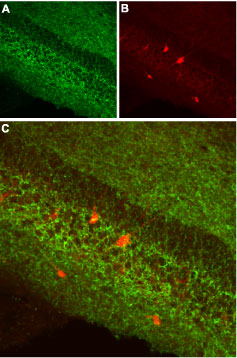Overview
Cat #: BLP-CR001
Type: Synthetic peptide
Form: Lyophilized powder
Cannabinoid Receptor 1 (extracellular) Blocking Peptide (#BLP-CR001) is the original antigen used for immunization during Anti-Cannabinoid Receptor 1 (extracellular) Antibody (#ACR-001) generation. The blocking peptide binds and ‘blocks’ Anti-Cannabinoid Receptor 1 (extracellular) primary antibody, this makes it a good negative reagent control to help confirm antibody specificity in western blot and immunohistochemistry applications. This control is also often called a pre-adsorption control.
Applications: wb, ihc
Application key:
WB- Western blot, IHC- Immunohistochemistry
For research purposes only. not for human use
Applications
Demonstration of Pre-adsorption control
 Western blot analysis of rat brain membrane proteins:1. Anti-Cannabinoid Receptor 1 (extracellular) Antibody (#ACR-001), (1:200).
Western blot analysis of rat brain membrane proteins:1. Anti-Cannabinoid Receptor 1 (extracellular) Antibody (#ACR-001), (1:200).
2. Anti-Cannabinoid Receptor 1 (extracellular) Antibody, preincubated with Cannabinoid Receptor 1 (extracellular) Blocking Peptide (#BLP-CR001). Expression of CB1 receptor in mouse hippocampusImmunohistochemical staining of mouse hippocampus using Anti-Cannabinoid Receptor 1 (extracellular) Antibody (#ACR-001), (1:100). A. CB1 is detected in pyramidal and infra-pyramidal layers (green). B. Staining of interneurons using mouse anti-parvalbumin (PV) antibody (red). C. Confocal merge of A and B does not indicate the presence of CB1 in GABAergic cells.
Expression of CB1 receptor in mouse hippocampusImmunohistochemical staining of mouse hippocampus using Anti-Cannabinoid Receptor 1 (extracellular) Antibody (#ACR-001), (1:100). A. CB1 is detected in pyramidal and infra-pyramidal layers (green). B. Staining of interneurons using mouse anti-parvalbumin (PV) antibody (red). C. Confocal merge of A and B does not indicate the presence of CB1 in GABAergic cells. Expression of CB1 receptor in rat hippocampusImmunohistochemical staining of rat hippocampus using Anti-Cannabinoid Receptor 1 (extracellular) Antibody (#ACR-001) (1:100). A. CB1 is detected in pyramidal and infra-pyramidal layers (green). B. Staining of interneurons using mouse anti-parvalbumin (PV) antibody (red). C. Confocal merge of A and B does not indicate the presence of CB1 in GABAergic cells.
Expression of CB1 receptor in rat hippocampusImmunohistochemical staining of rat hippocampus using Anti-Cannabinoid Receptor 1 (extracellular) Antibody (#ACR-001) (1:100). A. CB1 is detected in pyramidal and infra-pyramidal layers (green). B. Staining of interneurons using mouse anti-parvalbumin (PV) antibody (red). C. Confocal merge of A and B does not indicate the presence of CB1 in GABAergic cells. Western blot analysis of mouse brain lysates (lanes 1 and 3) and rat brain membranes (lanes 2 and 4):1-2. Guinea Pig Anti-Cannabinoid Receptor 1 (extracellular) Antibody (#ACR-001-GP), (1:400).
Western blot analysis of mouse brain lysates (lanes 1 and 3) and rat brain membranes (lanes 2 and 4):1-2. Guinea Pig Anti-Cannabinoid Receptor 1 (extracellular) Antibody (#ACR-001-GP), (1:400).
3-4. Guinea Pig Anti-Cannabinoid Receptor 1 (extracellular) Antibody (#ACR-001-GP), preincubated with Cannabinoid Receptor 1 (extracellular) Blocking Peptide (#BLP-CR001). Expression of Cannabinoid Receptor 1 in mouse hippocampus.Immunohistochemical staining of perfusion-fixed frozen mouse brain sections with Guinea Pig Anti-Cannabinoid Receptor 1 (extracellular) Antibody (#ACR-001-GP), (1:200), followed by goat anti-guinea pig - Alexa Fluor-594. A. Staining in the dentate gyrus region, showed CB1R immunoreactivity (red) in axonal outlines in the outer molecular layer (arrows pointing down) and in the hilus (arrows pointing up). B. Pre-incubation of the antibody with Cannabinoid Receptor 1 (extracellular) Blocking Peptide (#BLP-CR001), suppressed staining. Cell nuclei are stained with DAPI (blue). G = granule layer, H = hilus.
Expression of Cannabinoid Receptor 1 in mouse hippocampus.Immunohistochemical staining of perfusion-fixed frozen mouse brain sections with Guinea Pig Anti-Cannabinoid Receptor 1 (extracellular) Antibody (#ACR-001-GP), (1:200), followed by goat anti-guinea pig - Alexa Fluor-594. A. Staining in the dentate gyrus region, showed CB1R immunoreactivity (red) in axonal outlines in the outer molecular layer (arrows pointing down) and in the hilus (arrows pointing up). B. Pre-incubation of the antibody with Cannabinoid Receptor 1 (extracellular) Blocking Peptide (#BLP-CR001), suppressed staining. Cell nuclei are stained with DAPI (blue). G = granule layer, H = hilus.
Properties
Sequence
Accession (Uniprot) Number P20272
Peptide Confirmation Confirmed by amino acid analysis and mass spectrometry.
Purity >70%
Storage Before Reconstitution Lyophilized powder can be stored intact at room temperature for two weeks. For longer periods, it should be stored at -20°C.
Reconstitution 100 µl double distilled water (DDW).
Concentration After Reconstitution 0.4 mg/ml.
Storage After Reconstitution -20°C.
Antigen Preadsorption Control 1 μg peptide per 1 μg antibody.
Standard Quality Control Of Each Lot Western blot analysis.

